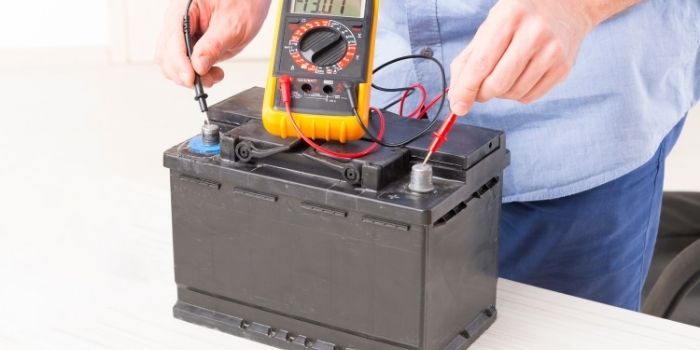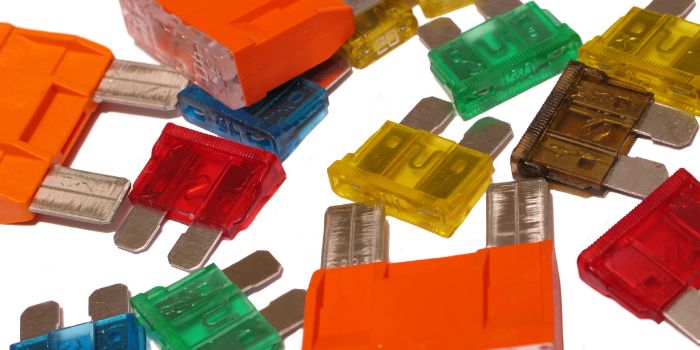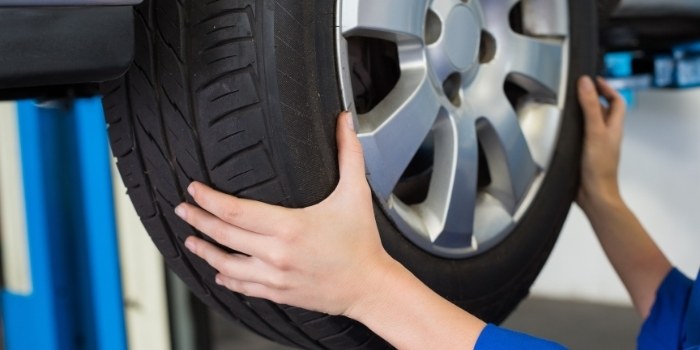
A lot of car owners believe that larger wheels are more visually appealing due to their lower sidewalls.
This allows more of the wheel to be put on display. Looks aren’t the only thing that should be taken into consideration when choosing wheel size, however.
Having larger wheels can affect things such as fuel economy, acceleration, and general performance.
The question usually comes down to whether 18-inch or 20-inch wheels are better, especially when it comes to differences when driving.
Below, we will explore the pros and cons of each with answers to this question in detail.
18-Inch Tyres for Car
When it comes to choosing the perfect wheel size, 18-inch wheels often hit that sweet spot between comfort, style, and practicality.
They’re like the Goldilocks option — not too big, not too small, just right for everyday driving.
But what exactly makes them so popular among car enthusiasts and city cruisers alike? Let’s roll through the details.
1. Ride Comfort – Smooth Operator
If your priority is comfort over corner-carving thrills, 18-inch wheels are your best bet.
- The slightly taller tyre sidewalls that pair with 18-inch wheels absorb road bumps and potholes much better than low-profile 19” or 20” tyres.
- This means less jarring, fewer rattles, and a noticeably smoother ride — perfect for long drives or rough city roads.
In short, your spine will thank you.
2. Handling & Control – The Balanced Performer
18-inch wheels strike a perfect balance between agility and stability.
- They provide enough sidewall flexibility to handle everyday bumps while still giving you decent cornering confidence.
- You’ll get a good feel of the road without the “every pebble vibration” that larger wheels often deliver.
So, if you want responsive handling without turning your car into a go-kart, 18s keep you comfortably in control.
3. Fuel Efficiency – The Mileage Friend
Here’s a bonus: 18-inch wheels are generally lighter than larger ones, meaning your engine doesn’t have to work as hard to get moving.
- Less rotational mass = better fuel efficiency.
- Plus, tyres for 18-inch wheels are often cheaper and easier to find — your wallet wins again.
Bigger wheels might grab attention, but 18s quietly save you money every mile.
4. Aesthetics & Practicality – The Perfect Compromise
Let’s be honest — we all want our car to look good. And 18-inch wheels offer plenty of visual punch without overdoing it.
- They fill out the wheel arches nicely, giving your car a confident stance.
- At the same time, they leave enough tyre cushion for comfort and protection against curb kisses.
In short, they’re stylish without being high-maintenance divas.
20-Inch Wheels for Your Car
If 18-inch wheels are the practical all-rounders, 20-inch wheels are the bold statement-makers.
They’re the gym-fit cousins of the wheel world — muscular, confident, and built to turn heads.
But beyond the good looks, 20-inch wheels change how your car feels on the road — for better and for worse.
Let’s break down what you’re really signing up for when you go big.
1. Style & Street Presence – The Showstopper Factor
Let’s be real — most people upgrade to 20-inch wheels for one reason: they look amazing.
- They fill the wheel arches perfectly and give your ride that “premium, high-performance” stance.
- Whether it’s a sporty sedan or a beefy SUV, 20s scream confidence and instantly elevate the overall look.
If turning heads in traffic is your thing, 20-inch wheels deliver. They’re basically the automotive equivalent of wearing designer shoes — functional, but mostly for the flair.
2. Handling & Performance – Sharper, But Stiffer
With great size comes great… stiffness.
- 20-inch wheels usually come with low-profile tyres (thinner sidewalls), which improve cornering precision and steering response.
- The car feels tighter and more connected to the road, especially on smooth highways.
But here’s the catch: every pothole and speed bump becomes more noticeable. So while your car corners beautifully, your spine might not be applauding.
3. Fuel Efficiency & Ride Quality – The Trade-Off Zone
Bigger wheels are heavier, and heavier wheels mean more work for the engine.
- Expect slightly lower fuel economy and a firmer ride compared to smaller wheels.
- The increased rolling resistance and weight can add a few extra sips to your car’s fuel appetite.
In short, 20s look great, but they’re not exactly fuel-sipping saints.
4. Cost & Maintenance – Beauty Isn’t Cheap
Larger wheels don’t just cost more to buy; they cost more to maintain.
- Low-profile tyres wear faster and are pricier to replace.
- The lower sidewalls also make the wheels more vulnerable to curb damage and pothole impacts.
In other words, 20-inch wheels demand a little extra TLC — and budget.
18-Inch vs. 20-Inch Tyre Difference
| 18-Inch Wheels | 20-Inch Wheels |
|---|---|
| Economically priced | More expensive |
| Lighter weight | Heavier weight |
| Improves acceleration and performance | Increases traction due to the larger size |
| Smoother, more comfortable ride but weaker traction | Better for driving in icy or muddy conditions |
| Less aesthetically pleasing | Tends to have more visual appeal |
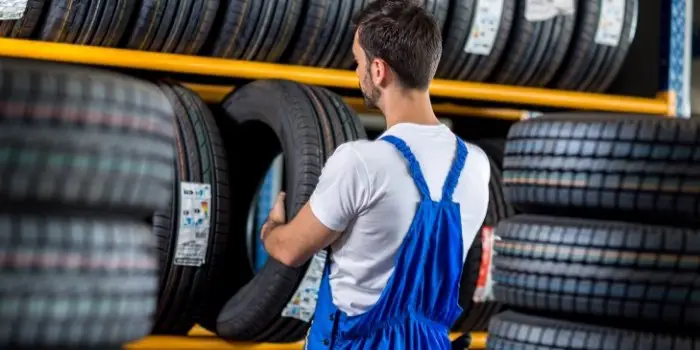
20 Inch vs. 18 Inch Wheels – Which One is Best?
Choosing between 18-inch and 20-inch wheels isn’t just a matter of aesthetics — it’s about comfort, performance, fuel efficiency, and everyday practicality.
Let’s break it down so you can make an informed decision without regretting it after the first pothole.
1. Ride Comfort – Who Wins the Smooth Ride?
18-inch wheels come with taller tyre sidewalls, giving your car a softer, more forgiving ride. They absorb bumps, potholes, and uneven roads effortlessly, making daily commutes and long trips much more comfortable.
20-inch wheels, on the other hand, sport low-profile tyres with shorter sidewalls. This means sharper handling but a firmer ride. Every speed bump, crack, and pebble becomes noticeable — fun for thrill-seekers, less fun for those who value their spine.
Winner: 18-inch wheels for comfort.
2. Handling & Performance – Sporty or Balanced?
If you crave responsiveness and precise cornering, 20-inch wheels deliver. The larger diameter and low-profile tyres enhance steering feedback and road grip, making your car feel sportier.
18-inch wheels offer balanced handling — good for everyday driving, city traffic, and long journeys — without making your ride overly stiff.
Winner: 20-inch wheels for sporty performance; 18-inch for daily practicality.
3. Fuel Efficiency & Maintenance
Smaller 18-inch wheels are lighter, meaning your engine works less and your fuel economy stays healthy. They’re also cheaper to replace, and the taller sidewalls protect against pothole damage.
20-inch wheels are heavier, consume slightly more fuel, and the tyres cost more to replace. Low-profile tyres are also more vulnerable to curb and pothole damage.
Winner: 18-inch wheels for fuel and maintenance savings.
4. Style Factor
Let’s be honest — 20-inch wheels look aggressive and premium. They fill the wheel arches nicely and give your car a confident stance. 18-inch wheels are subtle but still stylish enough for a clean, balanced look.
5. Braking & Safety – Stop Smarter
Wheel size can subtly influence braking performance.
- 20-inch wheels often improve high-speed stability and provide slightly better braking on smooth, dry roads due to larger contact patches. However, low-profile tyres may heat up faster and lose grip sooner on rough roads.
- 18-inch wheels offer more forgiving sidewalls, which absorb impact and maintain consistent grip under varied conditions, reducing the risk of skidding or uneven braking on uneven surfaces.
Winner: 18-inch wheels are generally safer and more consistent for everyday driving, while 20-inch wheels excel in controlled, sporty environments.
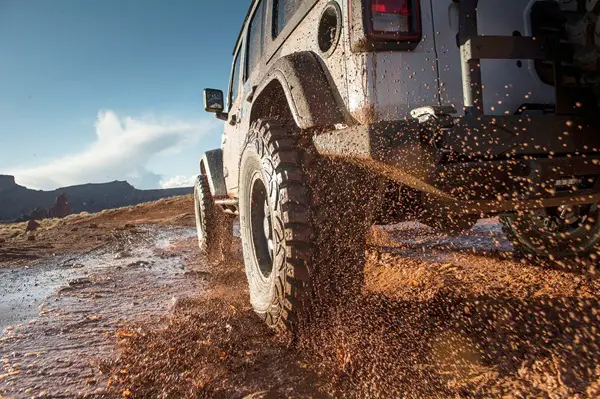
Which Tyres are Better for Off-Roading and Snow?
When it comes to off-roading or driving in snow, the rule of thumb is: smaller rims with taller, rugged tyres.
This provides better grip, absorbs bumps, and reduces the risk of rim damage.
- Rim Size: 18-inch wheels are generally preferred for off-road and snowy conditions. The taller tyre sidewalls improve traction on uneven terrain and snow, acting as natural shock absorbers.
- Tyre Type: All-terrain (A/T) or mud-terrain (M/T) tyres are ideal for off-roading, while winter tyres with deep treads are essential for snowy roads.
Examples of vehicles and setups:
- Jeep Wrangler – 18-inch rims with BFGoodrich All-Terrain tyres for rocky trails and mud.
- Toyota Land Cruiser / 4Runner – 18-inch rims with all-terrain tyres for both off-road adventure and snow.
- Land Rover Defender / Discovery – 18-inch rims with chunky all-terrain or winter tyres for rugged performance.
- Ford Bronco – 18-inch rims paired with mud-terrain tyres for off-road traction.
So, for off-roading and snowy conditions, stick to 18-inch rims with taller, all-terrain or winter tyres.
They balance durability, grip, and comfort, keeping both your vehicle and passengers safe on rough or slippery terrain.
Low-profile 20-inch tyres are less forgiving on rocks, deep snow, or muddy terrain. They’re more prone to damage and provide less traction in challenging conditions.
Is It Okay to Go From 18-Inch Wheels to 20-Inch Wheels?
Yes, you can go from 18-inch to 20-inch wheels, but it’s important to consider comfort, fuel economy, maintenance costs, and fitment.
Many car owners upgrade for style or sporty handling, but doing it responsibly ensures your ride stays safe, balanced, and enjoyable.
Here’s a clear, concise pros-and-cons table comparing 18-inch vs. 20-inch wheels specifically for upgrades:
| Feature | 18-Inch Wheels | 20-Inch Wheels |
|---|---|---|
| Ride Comfort | Taller sidewalls absorb bumps; smoother ride | Low-profile tyres; firmer, harsher ride over rough roads |
| Handling & Performance | Balanced handling; good for everyday driving | Sharper steering and cornering; better on smooth roads |
| Fuel Efficiency | Lighter; engine works less; better mileage | Heavier; increased rolling resistance; slightly lower fuel efficiency |
| Cost & Maintenance | Tyres cheaper and easier to replace; more durable | Tyres expensive; low-profile more prone to curb/pothole damage |
| Aesthetics & Street Presence | Subtle, balanced look | Bold, aggressive stance; premium appearance |
| Speedometer Accuracy | Accurate with stock setup | May require recalibration due to diameter changes |
| Safety & Grip | Sidewalls absorb impact; consistent grip on varied roads | Larger contact patch; better grip on smooth surfaces but less forgiving over bumps |
Do 20-Inch Rims and Tyres Affect the Transmission and MPG?
Upgrading to 20-inch rims gives your car a bold, sporty look and sharper handling, but it comes with a trade-off that can subtly affect your car’s performance, including transmission stress and fuel efficiency (MPG).
Here’s why.
1. Increased Rotational Mass
Larger rims are heavier than smaller ones. This added mass increases rotational inertia, meaning the engine and transmission must work harder to accelerate and decelerate the wheels.
- Automatic transmissions may shift differently to handle the extra load, potentially feeling slightly slower or “heavier” during acceleration.
- Manual transmissions may require more effort to change gears at low speeds.
This doesn’t typically damage the transmission if the car is used normally, but it does put extra strain over time, especially in stop-and-go city traffic or aggressive driving conditions.
2. Impact on Fuel Efficiency (MPG)
Heavier rims and low-profile tyres increase rolling resistance, which means the engine burns more fuel to maintain the same speed.
- On average, switching from 18-inch to 20-inch rims can reduce MPG by 2–5%, depending on tyre width and weight.
- Wider tyres also increase aerodynamic drag slightly, further impacting fuel consumption.
3. Other Considerations
- Larger rims often require lower-profile tyres to maintain overall wheel diameter. These tyres have less sidewall flex, which improves cornering but can make the ride stiffer.
- Speedometer and odometer readings may be slightly off if the overall wheel diameter changes, affecting perceived MPG calculations.
While you should expect slightly reduced fuel efficiency and a small increase in transmission workload with 20-inch rims, choosing high-quality, lightweight rims can minimize these effects while keeping your ride stylish and responsive.
Final Thoughts
There’s no one-size-fits-all answer when it comes to choosing between an 18-inch tyre and a 20-inch tyre for your vehicle.
Choose 18-inch wheels if comfort, fuel efficiency, and practicality are your priorities. Go for 20-inch wheels if sporty looks, sharper handling, and street presence matter more.
Ultimately, the “best” wheel depends on your lifestyle, driving conditions, and personal taste.

Based in Orem (Utah) John Paterson graduated from Utah Valley University and has begun writing in 2009. He has a large wealth of experience in writing articles related to cars, automotive repair, wheels, cleaning/maintenance, and much more. He has also written instructional articles in a similar niche for a few online publications as well. Currently, he works as a mechanic in his personal garage shop where he loves serving his countrymen from his heart.

